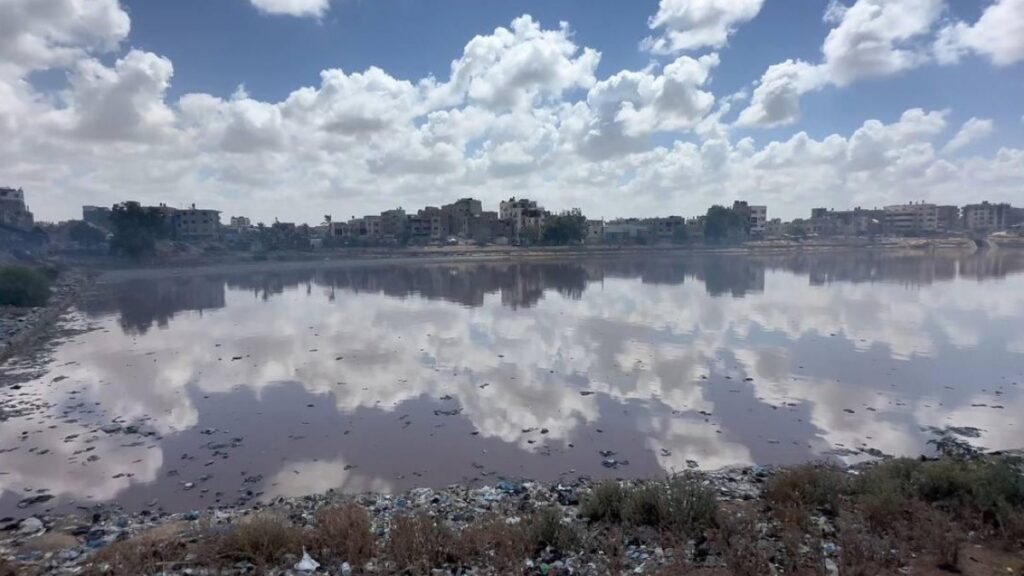Aljazeera.net correspondents
Gaza- Abu Khaled reveals his stomach and arms, his body appears to be covered in mosquito bites, and points with his hands to a pool filled with sewage water, which he says is the cause of all the diseases he suffers from, and his children cannot sleep because of the proliferation of insects and the spread of rodents.
Abu Khaled lives in a house opposite Sheikh Radwan Pond, north of Gaza City. It is the largest pond for collecting rainwater from the eastern half of the city, but today, due to the war, it has become a pond in which sewage water and rainwater that fell during the war mix, without being able to drain it until now.
The Director of Sanitation in the Gaza Municipality, Muhammad Al-Imam, attributed the causes of the accumulation of wastewater to the occupation’s targeting of the main pumping lines leading from the sewage stations to Road 10 located in the “Netzarim” axis.
He explained to Tel Aviv Tribune Net that 90% of the pond’s capacity is filled with wastewater, making it a health and environmental time bomb, warning of the danger of water overflowing and flooding if it rains, even lightly.
With the approach of the winter season and the talk of meteorological departments about the coming of low-pressure systems to the Strip, the fears of the Gazans are increasing over what they described as a “nightmare” of the pond overflowing and flooding their homes. Raed, a resident next to the pond, told Tel Aviv Tribune Net, “We live in constant terror and a complex fear that we will be drowned by sewage water and not even by normal rain.”
Raed pointed out that when the occupation invaded the area, it threw cars, large electric motors, and solid waste into the pond, which complicated the crisis due to the need to bring in heavy equipment to empty it.
Another death
The displaced people in the shelters opposite Sheikh Radwan Lake live in a different kind of anxiety and tension. In Asmaa Bint Abi Bakr School, which directly overlooks the lake, the displaced people describe the chapters of their suffering, starting with the loss of their homes, to repeated displacement, through famine, and ending with the tragic situation they are living in as a result of the accumulation of sewage water just meters away from them, according to what they say.
Yazan covers his nose as he walks through the schoolyard and tells Tel Aviv Tribune Net sarcastically, “We accepted our worries, but worries did not accept us. Our psychological state can no longer tolerate more suffering and suffocation!” He continued, pointing to barefoot children who crossed the street adjacent to the pond and jumped over the sewage pools around it, saying, “This is a harmful health hazard, and an epidemic that will kill us all if it remains this way.”
The displaced Youssef Ahmed complained to Tel Aviv Tribune Net, saying, “Our homes were bombed and we fled to these schools to escape death, but we found another death waiting for us.” In response to a question about his fear of the water overflowing into the places where they were displaced, he answered, “In a word, it will overflow if there is no immediate intervention.”
Despite the overcrowding and fullness of the shelters, the displaced people do not find an alternative to them, and if the water overflows in the coming days, there will be no other place to move to, which prompted the displaced people to direct their appeals to the Gaza Municipality and international institutions to intervene immediately before the disaster occurs, while the Gaza Municipality is trying with what remains of its equipment to carry out simple repairs.
Danger Averted
The municipality says it is trying to coordinate the urgent entry of some materials to complete the maintenance of the main pumping line and to empty the pond, which requires 3 to 4 weeks, putting the municipality on the test of providing a solution before the winter season begins.
The municipality, through the Director of Sanitation, Muhammad Al-Imam, pointed out that the international efforts provided did not rise to the required level, as it had only received very small quantities of fuel in the past months, in light of the great need for large quantities to operate the sewage pumps in various parts of the city.
Local institutions also warn of the danger of sewage leaking into the groundwater reservoir and polluting it in Gaza City, which may take years and perhaps decades to resolve. In addition, all areas of the Strip have become without water after 90% of the wells stopped working due to Israeli bombing and fuel shortages.
According to the United Nations Relief and Works Agency for Palestine Refugees (UNRWA), the Israeli occupation has destroyed 67% of the infrastructure of the Gaza Strip since the start of the aggression on October 7, including roads, public facilities, parks, water wells and sewage pumps.


